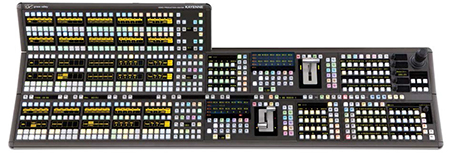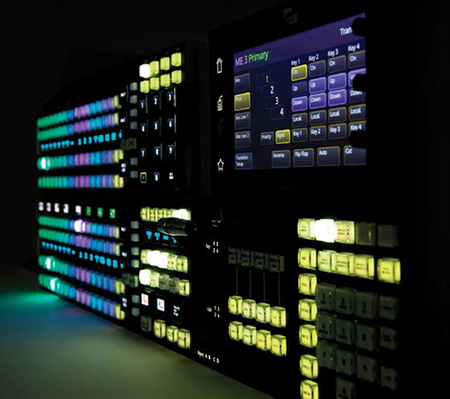Switchers Adapt to an IP, UHD World
HAMILTON, N.J.—More than ever, the real excitement in broadcast television is live production. Viewers want to experience major events, such as sports, breaking news and elections, firsthand as they unfold. And the video production switcher has long been at the center of it all, taking all the signals in, processing them and outputting the live show.
While today’s switchers need to maintain the highest production standards, they must also adapt to new forces reshaping the industry, such as 4K/UHD, high dynamic range (HDR), and the IP transition. Just in terms of IP, switchers need to support new SMPTE standards, such as SMPTE 2022-6 and SMPTE-2110, as well as 12G SDI, 4K TICO compression, remote production, online streaming, and even cloud-based capabilities.
RISING TO NEW STANDARDS
Regardless of what the new format or trend is, “no broadcaster wants to sacrifice the look and feel of their on-air product,” said Greg Huttie, vice president of switcher products for Grass Valley. “And more importantly, viewers don’t want to watch a lesser quality show just because it’s now in 4K or IP. If they don’t see multiple boxes on screen, cool graphics, replays, tickers, strike zone tracking, the first-down line, or whatever whiz-bang elements they’ve come to expect, they’ll be disappointed.”
That’s why our production switchers handle the greater processing demands of IP, UHD, HDR and other dramatic new advances without short-changing today’s high production standards, or negatively impacting the familiar live production workflow experience that technical directors and engineers have come to know.”

Grass Valley Kayenne Grass Valley’s Kayenne Control Panel pairs with the company’s K-Frame video processing engine, which supports switching between a mix of IP and SDI infrastructures, including 1080p 3G, 12G SDI, SMPTE 2022-6, and 4K over 1-wire TICO-compressed IP. For UHD shows, 1080p sources can be upconverted in the switcher to 4K, and native 4K/UHD signals can be switched in either 2SI (two sample interleave) or SDQS (square division quadrant). In 2SI mode, upconversion is done automatically for all sources. Grass Valley LDX cameras and switcher hardware also support HDR for brighter, crisper images.
NEW-AGE DESIGN
The DYVI IP-based production switcher—from Belgium-based EVS—is a next-generation switching platform capable of a decentralized and distributed production configuration. With this architecture, users are no longer constrained by hardware, such as the number of M/Es, keyers or proprietary hardware of any kind.
“As an IP switcher with SDI capability added on, DYVI is at the opposite end of the spectrum from legacy switchers,” said James Stellpflug, vice president of product marketing for Belgium-based EVS, with U.S. headquarters in Fairfield, N.J. “Its flexible design lets users scale from HD to 4K and beyond.” By eliminating traditional baseband signal routing concerns, DYVI’s configuration can scale from single user/single location to multiuser/multilocation networks.
Get the TV Tech Newsletter
The professional video industry's #1 source for news, trends and product and tech information. Sign up below.
“Rather than bringing all the camera signals back to your central control room, you can put DYVI processing modules wherever they’re needed, and control signals using IP as if they’re local,” Stellpflug said. “The control, visibility and access are done flexibly over IP, not using point-to-point wires and other constraining hardware.”
Hollywood Film Director Francis Ford Coppola used DYVI on his “Distant Vision” live cinema project, which can be described as a “hybrid” of theater, film and television (“Coppola Brings the Concept of Live to Cinema,” Broadcast Engineering Extra, November 2016). The switcher was used to cut feeds from 40 cameras to produce 17 scenes involving complex camera requirements. The ability to quickly configure DYVI for unlimited control panel setups, assignment and changes were particularly beneficial to the innovative project, according to Stellpflug.
With this switcher, layering, adding keys and performing visual transforms and effects are done using an onboard GPU card. “This approach offers more creative freedom and power,” he said. “Technology is shifting and we’re ahead of the curve.”
LIMITLESS PRODUCTION
NewTek IP Series, NewTek’s modular software-driven video/audio over IP production ecosystem is based on Newtek NDI (Network Device Interface). IP Series is comprised of the VMC1 Video Mix Engine, a four-stripe control panel, VMC1 IN Studio Input Module for ingesting SDI sources, and VMC1 OUT Studio Output Module for output in 3G/HD/SD-SDI. By adding NDI Connect Pro to the workflow, additional standards like ASPEN and SMPTE 2022-6 can be output.
“The IP Series is an integral part of an NDI ecosystem that leverages a standard gigabit Ethernet local area network and an affordable Cisco network switch that takes the place of a video router,” said Jorge Dighero, national key account manager for NewTek.
While the Studio Input Module accepts four inputs, the sources scale drastically when one or more NewTek Video Mix Engines—handling up to 44 inputs each—are networked. Instead of running miles of SDI cabling between video devices and transferring baseband from point-to-point, the IP Series has immediate access to any of the sources on the interconnected IP modules, regardless of where they are on the LAN. Upon input or output, SDI signals are converted to and from NDI—a broadly supported IP video networking protocol—with virtually no latency or sync issues.
“With the IP Series, we have removed the constraints inherent in switching SDI baseband video, even within the switcher itself, where processing is done entirely in the IP domain,” Dighero added. “And with NDI, we can make live IP production more affordable, and easier to implement than SDI, even at 4K/UHD resolutions.”

SAM KahunaDELIVERING THE WOW FACTOR
SAM’s enterprise-class Kahuna live production switchers include 4-, 12- and 24- M/E models, while its Kula—a compact 1-2 M/E switcher—targets mid- and smaller-sized markets.
“Right now, our customers have many big decisions to make about their underlying infrastructure, whether to continue in SDI, adopt the 12-Gig single-link standard, advance to 4K/UHD or make the leap of faith to IP,” said David Tasker, vice president of systems & technology, Americas for SAM. “And when switching between all these formats, production people consider latency a top concern.”
To manage latency, SAM switchers offer FormatFusion3, which provides up/down conversion within the M/E bus, rather than via external standards converters. “This internal signal processing reduces system timing issues to about a frame of latency and ensures proper lip sync,” Tasker said. “This capability benefits from the same technology found in our Alchemist standards converter.”
Going forward, SAM plans to support HDR and standard dynamic range (SDR), as well as wider color gamut, wherever possible across its product line, leveraging HDR expertise from its Rio color editing and finishing system. Tasker said that many broadcasters are more enthusiastic about combining HDR with 1080p HD than they are about making costly upgrades to support a UHD infrastructure. “They feel that HDR delivers a bigger ‘wow factor’ than the increased resolution,” Tasker said. “So it’s very important for our switchers to support both HDR and SDR, and manage a mix between the two, transparently to the operator.”
SAM will have a very strong presence at the 2017 NAB Show, according to John Shike, vice president, business development, Americas for SAM. “With our accelerated pace of R&D, we will have even more new developments than we did at IBC, which was our strongest IBC to date,” he said.
IP ECOSYSTEM
Following its September 2016 acquisition of IO Gates, an innovator of cloud-based video production management, Broadcast Pix has leveraged that technology into BPNet, a new entry-level cloud-based IP ecosystem available across its integrated production switcher line. BPNet not only allows the switchers to input and output IP- and NDI-based media, they are integrated within an IP ecosystem for sharing, managing and storing content in the cloud.
“People want to use the cloud along with their standard GigE local area networks as an integral part of their media content creation and distribution,” said Tony Mastantuono, Product Manager for Broadcast Pix. “BPNet enables our switchers to integrate in the cloud as well as distribute video to IP-based outlets.”
“With our switchers, customers can also create a customized, branded Web portal that serves as an online broadcast platform as well as deliver live video via venues like Facebook Live and YouTube,” Mastantuono added. “We also offer a mobile app that lets mobile journalists and others in the field ingest video using their smartphones and deliver it to the cloud, making it immediately available as a source that our switchers can use in a live show.”
While all Broadcast Pix switchers have these new capabilities, the lower-end Roadie and Flint models also integrate HD streaming. At the high-end, the 2 M/E Granite supports 22 multi-def SDI inputs with 12 outputs, six layers of keying with DVEs, CG graphics and BPView for multiviewer monitoring.
BPCommand can be added for customizable, automated control that makes complex productions easier to run from an intuitive touchscreen interface. Mastanuono said that, with BPNet, their switchers are growing in popularity in broadcast, as well as non-traditional video markets, such as the PEG, education, house of worship and government sectors.

Ross AcuityFOCUS ON VALUE
Ross Video’s top-of-the-line Acuity Series production switcher offers a powerful, future-oriented processing platform with an aesthetic, ergonomic design. It also offers multiprocessor support for SD, HD, 3G or Quad Link 3G SDI for 4K/UHD productions, as well as a multiviewer for monitoring input sources.
To provide an interface with the IP domain, Ross also recently introduced the Raptor IPG-8970/IP Gateway multiprotocol solution for the openGear signal processing platform. This card creates a bridge between live SDI video production equipment, such as switchers, and the growing packet-based studio infrastructure. It supports SMPTE 2022-6, VSF TR-03/TR-04, among other encapsulation modes.
“This IP Gateway enables facilities to deliver product into the IP domain without changing over their entire SDI infrastructure,” says Les O’Reilly, marketing product manager for Ross switchers. “While virtually every customer today is delivering video to IP and internet sites, the cost of producing in IP is more expensive, and not as well defined, as SDI. Video facilities don’t have to abandon SDI to serve the IP world.”
For the rapidly growing midsize market, Ross offers the Carbonite production switcher line, including the Black Solo Series, which includes the live Xpression CG package, that runs on any Windows PC with an NVidia graphics card. High-quality graphics are delivered over an IP connection between the two.
Since this market tends to be price-sensitive, Carbonite switchers offer the essential features and capabilities required by mid-market users, such as corporations, schools, churches and secondary DTV broadcast applications and control rooms.
“We don’t integrate live streaming capabilities into Carbonite switchers because that function would tax the available processing power and compromise performance,” O’Reilly said. “But by utilizing any third-party streaming encoder card available on our openGear platform, our customers can stream programs cost-effectively with an outboard device without having to compromise the switcher’s performance or pay a premium for integrated streaming functionality.”
SOPHISTICATED CAMERA CONTROL
RUSHWORKS is now shipping its new VDX 12-input control surface, custom-designed for its VDESK Integrated Production System in response to customer requests. According to company president Rush Beesley, “VDESK can be operated with the included 23-inch touchscreen, as well as with a keyboard and mouse. The VDX USB control panel appeals to operators that want a traditional switcher panel with keyboard shortcuts and a T-bar for manual transition control.“
Both VDESK and REMO—the ruggedized remote version—integrate a 4-, 8- or 12-camera input switcher, as well as effects, transitions, chroma-key, local encoding and streaming, playlist creation and other features. The system provides three user interfaces—Classic, Producer and Talking Points—that make it simple for anyone to produce a professional multicamera show with no camera operators required.
“While there’s a video production switcher at the core, the key distinguishing feature of VDESK is sophisticated camera control capability,” said Beesley. “By simply touching picture icons on the user interface, an individual can move the camera to that preset and automatically take the shot.”

